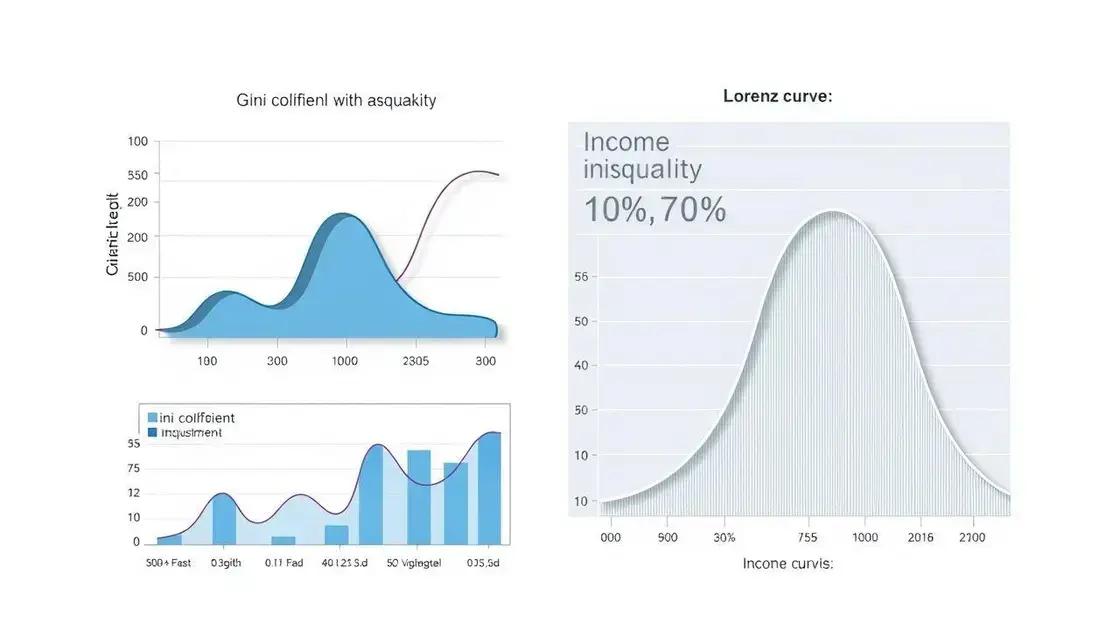Income inequality measures: understanding their impact

Anúncios
Income inequality measures are critical tools for assessing wealth distribution and identifying disparities, guiding effective policies to promote equity and improve economic opportunities for disadvantaged groups.
Income inequality measures play a critical role in understanding social dynamics. Ever wondered how they affect your daily life or influence political decisions? Let’s dive into their significance and impact.
Anúncios
What are income inequality measures?
Income inequality measures are vital tools that help us understand the distribution of income within a population. These metrics highlight disparities, offering insights into who benefits from economic growth and who does not.
Understanding these measures allows policymakers, researchers, and the public to grasp the core issues surrounding economic disparity. By examining various methods used to gauge income inequality, we can see how these statistics inform legislation and social programs.
Anúncios
Different Types of Income Inequality Measures
There are several key measures that capture income inequality. Each provides unique insights:
- Gini coefficient: This number ranges from 0 (perfect equality) to 1 (maximum inequality), expressing income distribution within a population.
- Income quintiles: These divide the population into five equal segments, helping to visualize disparities in income distribution.
- Palma ratio: This measure compares the share of income of the top 10% to the bottom 40%, shedding light on extreme inequality.
These metrics play a significant role in illustrating the economic landscape of any country. Observing trends over time can reveal if inequality is worsening or improving.
By analyzing the data produced by these measures, we gain a better understanding of the root causes of income imbalance. Factors like education level, economic policies, and even geographic location can all influence how income is distributed among individuals and families. The broader implications of these disparities often affect access to resources, opportunities, and overall quality of life.
As we delve further into the realm of income inequality measures, we uncover the real human stories behind the numbers. It’s not just data—it’s about people’s lives and their struggles for economic parity.
The importance of measuring income inequality
Measuring income inequality is crucial for understanding social and economic dynamics. These measures inform us about gaps between different income groups and help identify trends in wealth distribution.
By assessing income inequality, governments and organizations can develop targeted policies to address economic disparities. This understanding is essential as it influences everything from healthcare access to educational opportunities.
Why is it Essential?
Income inequality measures provide several key benefits:
- Informs policy decisions: Policymakers rely on these metrics to create effective social and economic policies.
- Promotes awareness: Understanding inequality fosters discussion about social justice and economic rights.
- Guides resource allocation: Identifying areas most affected by inequality allows for better allocation of resources.
When we measure income inequality, we can observe the health of an economy and its effects on various groups within society. Rising inequality often signals economic issues that need to be addressed, such as inadequate wages or lack of access to education.
Furthermore, understanding the reasons behind income inequality can lead to meaningful changes. Factors like globalization, technology, and discrimination often contribute to income disparities. Addressing these issues, based on solid measurements, can create a more equitable society.
In summary, recognizing the significance of measuring income inequality helps illuminate societal challenges and drives necessary policy changes. It becomes clear how these metrics are not just numbers, but essential tools in creating a more just and balanced world.
Key methods for assessing income inequality

There are several key methods used for assessing income inequality, each providing unique insights into the economic landscape. Understanding these methods can help us analyze the gaps between different income groups.
Some of the most common methods include:
1. Gini Coefficient
The Gini coefficient is one of the most popular measures of income inequality. It is represented as a number between 0 and 1, where 0 indicates perfect equality and 1 indicates maximum inequality. Economists use this coefficient to compare income distribution in different countries.
2. Lorenz Curve
The Lorenz curve visually represents income distribution. It plots the cumulative percentage of total income received against the cumulative percentage of the population. A straight diagonal line represents perfect equality, while the curve shows actual distribution. The more the curve bows away from the diagonal, the greater the inequality.
3. Income Quintiles
Dividing the population into income quintiles allows for an easy comparison between different income groups. By analyzing the share of total income received by the top 20% compared to the bottom 20%, we can see stark differences in economic well-being.
4. Palma Ratio
The Palma ratio compares the share of income of the top 10% to that of the bottom 40%. This ratio emphasizes the disparity between the very rich and the poorer population, offering another perspective on income inequality.
Using these methods helps researchers and policymakers track changes in income distribution over time. It also aids in identifying specific areas that may require attention or intervention to reduce inequality. When analyzing income data, it’s important to consider socioeconomic factors that could influence these measures.
Ultimately, understanding these key methods for assessing income inequality equips us with knowledge to address disparities effectively. Each method provides crucial information that can guide policies aimed at fostering equity and enhancing social welfare.
Income inequality measures across different countries
Examining income inequality measures across different countries reveals significant differences in wealth distribution. These measures help us understand how economic policies and social structures impact various populations.
Countries across the globe display varied levels of income inequality based on numerous factors. For instance, Nordic countries like Sweden and Norway typically report some of the lowest levels of inequality. This is largely due to robust social policies and progressive taxation systems.
Comparative Analysis
In contrast, nations such as the United States and Brazil show much higher levels of income inequality. Examining these differences provides insight into how government policies influence economic outcomes. Some key factors include:
- Taxation: Countries with higher taxes on wealth and income often see lower inequality.
- Access to education: Educational opportunities can lead to better jobs and income, reducing inequality.
- Labor market policies: Strong labor rights and minimum wage laws contribute to fairer income distribution.
Moreover, Asian countries like Japan and South Korea illustrate a unique perspective on income inequality. They experience moderate levels due to well-developed welfare systems that promote equitable growth. Understanding the blend of economic and social factors across these nations sheds light on potential solutions to combat income inequality.
As we analyze data from various countries, it becomes evident that no single approach fits all. Each nation must tailor its strategies based on unique circumstances and historical contexts. By learning from global examples, policymakers can better address the challenges posed by income inequality and work towards more equitable societies.
Addressing income inequality: policies and solutions
Addressing income inequality requires a multifaceted approach that involves various policies and solutions. These strategies aim to create a more equitable distribution of wealth and improve opportunities for disadvantaged groups. Understanding the different ways to combat this issue is essential for fostering social justice.
Many governments have implemented policies aimed at reducing income disparities. Some effective solutions include:
1. Progressive Taxation
Progressive tax systems help tax higher incomes at greater rates, which can redistribute wealth and fund social services.
2. Increasing Minimum Wages
Raising the minimum wage ensures that workers earn a livable income. This change supports families and reduces poverty levels.
3. Access to Education
Investing in education creates opportunities for all. Providing affordable or free education helps close the income gap by enabling people to gain better-paying jobs.
- Scholarships and grants: These financial aids make higher education more accessible.
- Vocational training: Programs that equip individuals with marketable skills can dramatically improve employment prospects.
The role of social safety nets cannot be overlooked either. Programs like unemployment benefits and food assistance can provide crucial help for those affected by income inequality.
Moreover, targeted initiatives focusing on specific groups, such as women and minorities, can further help close the income gap. These initiatives may include support for small businesses or mentorship programs.
As communities and nations work together to create fairer systems, it’s vital to evaluate the effectiveness of these solutions and adapt as needed. By implementing diverse strategies, the goal of reducing income inequality becomes more achievable, leading to improved welfare for all citizens.
FAQ – Frequently Asked Questions about Income Inequality Solutions
What policies can effectively reduce income inequality?
Progressive taxation, raising minimum wages, and increasing access to education are key policies.
How does education impact income inequality?
Access to quality education helps individuals secure better jobs, reducing income disparity.
Why is it important to measure income inequality?
Measuring income inequality allows us to understand economic disparities and create targeted solutions.
What are some examples of social safety nets?
Social safety nets include unemployment benefits, food assistance programs, and healthcare services.






